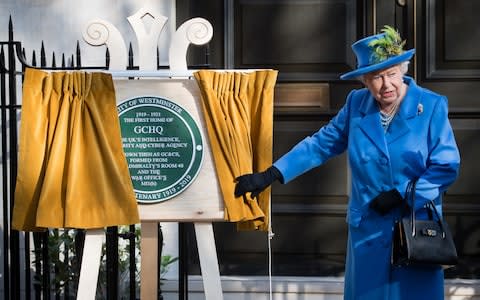GCHQ brainteaser: can you crack the code unveiled by the Queen?

Cracking a code devised by the masters of British intelligence is no easy task.
But now fans of brainteasers can pit their wits against GCHQ when they walk past the top secret agency's original headquarters in central London.
A plaque celebrating the centenary of the world famous organisation was unveiled by the Queen on Thursday at Watergate House near Charing Cross, but as well as the usual dedication and dates there are two hidden messages.
The puzzles consist of a series of dots and dashes which appear under various letters.
To reveal the first hidden message, passersby have to look out for where the dots and dashes appear on the plaque to reveal a three word phrase. For the second, would be spooks need to employ a famous encoding scheme to reveal a single word.
Continuing the code-breaking theme after the ceremony yesterday, The Queen sent an unusual thank you message.
The Royal Family's official Twitter posted: SVOOL TXSJ RG DZH TIVZG GL YV KZIG LU BLFI 100GS XVOVYIZGRLMH GSZMP BLF ULISZERMT FH.
And followers were challenged to decode the apparently jumbled series of letters and numbers.
GCHQ is one of Britain's three intelligence agencies along with MI5 and MI6.
The agency's director Jeremy Fleming said during the unveiling ceremony that the day marked 100 years of the organisation's role in "keeping the country safe".
Mr Fleming said: "In 1919, a hundred men and women walked down this street and came through those doors. They came together from the war office and the admiralty to form a suitably anonymous government code and cypher school.
"Our work is not often glamorous. It's not easily portrayed in film. But over the last 100 years it has saved countless lives, it has shortened wars, it has given Britain an edge and solved or harnessed some of the world's hardest technology challenges."
He added: "It's clear to us all that the world is changing at an unprecedented rate. It's more interconnected than ever before. And this is driving extraordinary opportunity, innovation and progress. But it's also unleashing amazing complexity, uncertainty and risk.
"To keep up in this digital era - to optimise the potential of new technologies like artificial intelligence or quantum computing - we know we need to keep reinventing."
Mr Fleming said that at the heart of the agency was the belief that "with the right mix of minds, anything is possible."
The Queen revealed that her father King George VI often became frustrated with his scrambler phone - an encrypted device which had been modified by GCHQ to keep his calls secret.

She said: "I remember my father had one, he used to get so cross when it didn't scramble. Took some time to heat up and then work."
A former Bletchley Park code-breaker was among the guests who attended the centenary celebration.
Ruth Bourne, 92, shared her experience of being a pivotal cog in the intelligence nerve centre in Milton Keynes, Buckinghamshire, during the Second World War.
She said: "I was operating the Turing Bombe machine, but I didn't realise the enormity of the work we were doing - all we were told was that we were breaking German codes.
"We didn't realise at the time how difficult it was going to be or that there were 159 million million million ways that one letter could be encrypted.
"The only thing we knew was that it was very important to be 100 per cent accurate. Perhaps I was clumsier than most, because I was told to be 150 per cent accurate!
"What the Germans didn't know was that the code was being slowly broken."
Also among the guests was the eldest grandson of GCHQ's first head Alastair Denniston, as well as Alex Younger, chief of the Secret Intelligence Service (MI6) and known as "C", and Andrew Parker, director general of MI5, the Secret Service.
Pupils from The Piggott School in Reading, Berkshire, who won the 2018 CyberFirst Girls competition devised by GCHQ, also attended the celebration.
They told the Queen how the competition had inspired their interest in computer science and possible code-breaking work in future.
“Sounds like you’re going to get more women,” the Queen said to Mr Fleming.
Think you've cracked the code? Here are the solutions...
Code 1 solution: One hundred years
If you pick out each number or letter which has a dot or a dash below it on the plaque above and read them out in the sequence they appear, it spells out '1 hundred years'.
Code 2 solution: secret
When read in Morse code, the same dots and dashes on the plaque spell out the word 'secret'.
S = dot dot dot
E = dot
C = dash dot dash dot
R = dot dash dot
E = dot
T = dash
Code 3 solution: Hello @GCHQ. It was great to be part of your 100th celebrations. Thank you for having us.
The cryptic message is solved by using an alphabetic code, in which A is Z, B is Y, etc.

 Yahoo News
Yahoo News 
